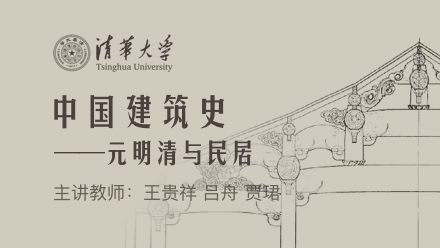
当前课程知识点:电路原理 > 第7周 非线性电阻电路(Nonlinear resistive circuits) > 第43讲 非线性电路的小信号法(small signal method for nonlinear circuits) > 非线性电路的小信号法(small signal method for nonlinear circuits)(3)
好了 有了刚才在工作点进行线性化的观点以后
我们就可以来讨论一个更为一般的问题
在这个问题里面
我们有一个叠加了直流的小信号
这个小信号呢可以理解为
是即将被放大的信号
也可以理解为是直流信号的扰动
还有一个线性电阻
还有一个压控型的非线性电阻
我们现在来列方程求解
在有扰动的情况下
我们定义整个电路的电流
是等于I0加上△it
我们定义非线性电阻上的电压
是等于U0加上△ut的
其中的U0和i0是指的
Us单独作用下那个工作点
回忆我们刚才的这样一个工作点
就是U0 I0的概念
好 现在我们来列写整个电路的方程
我们需要列写KVL方程
因此就是Us加上△Ust
是等于R乘以I0加上△it的
然后呢再加上U0加上△Ut
这是我们能够得到的方程
除此之外呢我们还知道
对于这个非线性电阻而言
I0和U0是它的工作点
因此我们有I0是等于gU0的
对于这个非线性电阻而言呢
现在加在它上面的电压是U0加上△U
流过它的电流是I0加△I
那么它们之间是一个非线性的关系
我们把这个非线性关系写出来
那就是I0加上△it是等于gU0加上△Ut的
这是一个非线性的关系
那么呢如果说
我们可以忽略二阶导及更高阶导的项
那么就可以近似的把它写成gU0再加上g′U0
就是在那个点的斜率的意思乘以△Ut
好 那么由于I0是等于gU0的
这一点我们一开始给出了
因此由这个方程我们可以得到
△It是等于g′U0乘以△Ut的
那么把这个结果
带回前面这个最根本的KVL方程
我们能够发现什么呢
这个方程就可以被拆成两个部分了
第一个部分是我们求直流工作点时的方程
那是Us等于R乘以I0加上U0
就是整个的这个部分
在这里呢I0和U0之间
是保持一个非线性的关系
这是第一个求解工作点的电路
那么把这些都消去了以后
我们发现有这样的一堆方程
把它们写出来就是
△Ust等于R乘以△It再加上△Ut
除此之外我们还可以把小信号关系写出来
那就是△It等于g′U0乘以△Ut
那么我们需要对这个g′U0做一个说明
它实际上的意思就是dg du在U等于U0时候的值
那么如果你在前面确定了U0的话
那么这个g′U0也是一个确定的值
大家请看这组方程
很显然是一个非线性代数方程
而这组方程是关于△Ut和△It的线性代数方程
这非常重要
这实现了我们在本讲第二页讲的一件事
也就是说我们可以利用人为施加的小信号来实现一些特殊的功能
对于小信号所在的电路或者说方程而言
激励和响应之间是线性的关系
这就非常便于我们用此前讲授的节点回路 叠加戴维南来进行分析和设计
好了 刚才是纯粹的数学推导
接下来我们把它电路化
大家请看左边这个方程
是刚才我们列写出来的
需要求解工作点的非线性代数方程组
我们不妨把这个代数方程组所对应的电路画出来
大家想想它应该是什么电路呢
很好 就应该是这样的一个电路
对吧 对于这个电路来讲
KVL得到这个方程
它上面的关系得到这个方程
求出来的工作点是U0和I0
更为重要的是对于右侧的这样一个
关于△It和△Ut的线性代数方程组来讲
我们从这个电路
怎样能够得到对应它的电路呢
这个方程还是一个KVL方程
于是在这里就需要写成
这是一个什么呢
从而使得它是△Ut
在这个上面△It和△Ut是一个什么关系呢
对的 这相当于是一个线性电阻
这个线性电阻的阻值是Gd分之一
那么在接下来的一讲里面
我们会给大家详细的分析
对应于我们常见的电路元件来讲
它所对应的这个小信号下的模型是怎样的
有了这个工具以后
大家就可以很方便的分析小信号电路了
在结束本讲之前
我们还要给大家提一个思考题
大家请看对于这样一个有两个电源激励的电路
我们把它分成了一个电源和另一个电源单独作用
而且我们明确的知道
它们的效果之和就是整个电路的It和Ut
那么请问 这个做法是叠加吗
-第0讲 数学基础知识(Math basics for circuits)
--数学基础知识(Math basics for circuits)(1)
--数学基础知识(Math basics for circuits)(2)
--数学基础知识(Math basics for circuits)(3)
--数学基础知识(Math basics for circuits)(4)
--数学基础知识(Math basics for circuits)(5)
--数学基础知识(Math basics for circuits)(6)
--数学基础知识(Math basics for circuits)(7)
-第1周 第0讲 数学基础知识
-第1讲 为什么要学习电路(why learn circuits?)
--为什么要学习电路(why learn circuits?)(1)
--为什么要学习电路(why learn circuits?)(2)
-第1周 第1讲 为什么要学习电路
-第2讲 电路(circuits)
-第1周 第2讲 电路(circuits)
-第3讲 支路变量(branch variables)
-第1周 第3讲 支路变量(branch variables)
-第4讲 参考方向(reference direction)
-第1周 第4讲 参考方向(reference direction)
-第5讲 功率(power)
--第一周 第5讲 功率(power)
-第6讲 电阻(resistor)
-第1周 第6讲 电阻(resistor)
-第7讲 独立电源(independent source)
--独立电源(independent source) (1)
--独立电源(independent source) (2)
-第1周 第7讲 独立电源(independent source)
-仿真1(simulation1)
-第8讲 端口(port)
--端口(port)
-第1周 第8讲 端口(port)
-第9讲 受控元件(dependent elements)
--受控元件(dependent elements) (1)
--受控元件(dependent elements) (2)
--受控元件(dependent elements) (3)
-第1周 第9讲 受控元件(dependent elements)
-仿真2(simulation2)
-第10讲 基尔霍夫定律(KCL KVL)
-第1周 第10讲 基尔霍夫定律(KCL KVL)
-第11讲 2B法(2B method)
--第1周 第11讲 2B法(2B method)
-第1周 作业
-第12讲 电阻的串并联(serial parallel resistors)
--电阻的串并联(serial parallel resistors) (1)
--电阻的串并联(serial parallel resistors) (2)
--电阻的串并联(serial parallel resistors) (3)
--电阻的串并联(serial parallel resistors) (4)
-第2周 第12讲 电阻的串并联
-第13讲 平衡电桥(bridge)
--第二周 第13讲 平衡电桥(bridge)
-第14讲 Y-Δ变换(Y-Δ transform)
--第二周 第14讲 Y-Δ变换(Y-Δ transform)
-第15讲 二端网络的等效电阻(equivalent resistance of two-terminal network)
--二端网络的等效电阻(equivalent resistance of two-terminal network)
--第二周 第十五讲 二端网络的等效电阻
-第16讲 电源的等效变换(equivalent transform for sources)
--电源的等效变换(equivalent transform for sources) (1)
--电源的等效变换(equivalent transform for sources) (2)
--电源的等效变换(equivalent transform for sources) (3)
-第2周 第16讲 电源的等效变换(equivalent tran
-第17讲 最大功率传输(maximum power transfer)
--最大功率传输(maximum power transfer)
--第二周 第17讲 最大功率传输
-第2周 第二周作业(Exercise2)
-第18讲 运算放大器(Op Amps)
-第3周 第18讲 运算放大器(Op Amps)
-第19讲 运算放大器模型(Op Amps' model)
-第3周 第19讲 运算放大器模型(Op Amps' m
-仿真3(simulation3)
-第20讲 理想运算放大器(ideal Op Amp)
-第3周 第20讲 理想运算放大器(ideal Op Amp)
-第21讲 运算放大器的应用(applications of Op Amps)
--运算放大器的应用(applications of Op Amps)(1)
--运算放大器的应用(applications of Op Amps)(2)
--运算放大器的应用(applications of Op Amps)(3)
-第3周 第21讲 运算放大器的应用(applications of Op Amps)
-第三周作业(Exercise3)
-第22讲 数字系统介绍(digital system —— introduction)
--数字系统介绍(digital system —— introduction)
-第4周 第22讲 数字系统介绍(digital system —— introduction)
-第23讲 数字系统——数和逻辑(digital system——number and logic in digital)
--数字系统——数和逻辑(digital system——number and logic in digital)(1)
--数字系统——数和逻辑(digital system——number and logic in digital)(2)
-第4周 第23讲 数字系统——数和逻辑
-第24讲 金属-氧化层半导体场效晶体管(MOSFET)
-第4周第24讲 金属-氧化层半导体场效晶体管(MOSFET)
-第25讲 逻辑门(logic gates)
-第4周 第25讲 逻辑门(logic gates)
-第26讲 互补金属氧化物半导体(CMOS)
-第4周 第26讲 互补金属氧化物半导体(CMOS)
-第27讲 二端口网络(two-port network)(不要求)
-第4周 第27讲 二端口网络(two-port network)
-第28讲 G参数(G parameter)(不要求)
-第4周 第28讲 G参数(G parameter)
-第29讲 其他参数(other parameters)(不要求)
-第4周 第29讲 其他参数(other parameters)
-第30讲 二端口网络的等效电路(equivalent circuits of two-port)(不要求)
--二端口网络的等效电路(equivalent circuits of two-port)
-第4周 第30讲 二端口网络的等效电路
-第31讲 二端口网络的连接(connection of two-ports)(不要求)
--二端口网络的连接(connection of two-ports)(1)
--二端口网络的连接(connection of two-ports)(2)
--二端口网络的连接(connection of two-ports)(3)
-第4周 第31讲 二端口网络的连接
-第四周作业(Exercise4)
-第32讲 系统化方程解法介绍(introduction to systematic function formulating)
--系统化方程解法介绍(introduction to systematic function formulating)
-第5周 第32讲 系统化方程解法介绍
-第33讲 节点电压法(node voltage method)
--节点电压法(node voltage method)(1)
--节点电压法(node voltage method)(2)
-第5周 第33讲 节点电压法
-第34讲 回路电流法(loop current method)
--回路电流法(loop current method)(1)
--回路电流法(loop current method)(2)
--回路电流法(loop current method)(3)
-第5周 第34讲 回路电流法
-第五周作业(Exercise5)
-第35讲 叠加定理(superposition theorem)
--叠加定理(superposition theorem)(1)
--叠加定理(superposition theorem)(2)
--叠加定理(superposition theorem)(3)
--叠加定理(superposition theorem)(4)
-第6周 第35讲 叠加定理
-第36讲 戴维南和诺顿定理(Thevenin/Norton theorem)
--戴维南和诺顿定理(Thevenin/Norton theorem)(1)
--戴维南和诺顿定理(Thevenin/Norton theorem)(2)
--戴维南和诺顿定理(Thevenin/Norton theorem)(3)
--戴维南和诺顿定理(Thevenin/Norton theorem)(4)
-第6周 第36讲 戴维南和诺顿定理
-第37讲 戴维南定理的应用(applications of Thevenin theorem)
--戴维南定理的应用(applications of Thevenin theorem)(1)
--戴维南定理的应用(applications of Thevenin theorem)(2)
--戴维南定理的应用(applications of Thevenin theorem)(3)
-第6周 第37讲 戴维南定理的应用
-第38讲 替代定理(substitution theorem)
-第6周 第38讲 替代定理
-第六周作业(Exercise6)
-第39讲 非线性电阻(nonlinear resistor)
--非线性电阻(nonlinear resistor)(1)
--非线性电阻(nonlinear resistor)(2)
-第7周 第39讲 非线性电阻
-第40讲 非线性电阻电路的方程求解法和图解法(analytical and graphical methods for nonlinear circuits)
--非线性电阻电路的方程求解法和图解法(analytical and graphical methods for nonlinear circuits)(1)
--非线性电阻电路的方程求解法和图解法(analytical and graphical methods for nonlinear circuits)(2)
-第7周 第40讲 非线性电阻电路的方程求解
-第41讲 非线性电路的分段线性法(piecewise linear method for nonlinear circuits)
--非线性电路的分段线性法(piecewise linear method for nonlinear circuits)(1)
--非线性电路的分段线性法(piecewise linear method for nonlinear circuits)(2)
--非线性电路的分段线性法(piecewise linear method for nonlinear circuits)(3)
--非线性电路的分段线性法(piecewise linear method for nonlinear circuits)(4)
--非线性电路的分段线性法(piecewise linear method for nonlinear circuits)(5)
-第7周 第41讲 非线性电路的分段线性法
-第42讲 假设检验法的应用(application of suppose-verify method)
--假设检验法的应用(application of suppose-verify method)(1)
--假设检验法的应用(application of suppose-verify method)(2)
-第7周 第42讲 假设检验法的应用
-第43讲 非线性电路的小信号法(small signal method for nonlinear circuits)
--非线性电路的小信号法(small signal method for nonlinear circuits)(1)
--非线性电路的小信号法(small signal method for nonlinear circuits)(2)
--非线性电路的小信号法(small signal method for nonlinear circuits)(3)
-第7周 第43讲 非线性电路的小信号法
-第44讲 小信号模型(small signal models)
--小信号模型(small signal models)(1)
--小信号模型(small signal models)(2)
--小信号模型(small signal models)(3)
--第七周 第44讲 小信号模型
-第45讲 放大器(amplifier)
--第七周 第45讲 放大器(amplifier)
-第七周作业(Exercise7)
-第46讲 电容与电感(Capacitors and Inductors)
--第46讲 电容与电感(Capacitors and Inductors)(1)
--第46讲 电容与电感(Capacitors and Inductors)(2)
--第46讲 电容与电感(Capacitors and Inductors)(3)
--第46讲 电容与电感(Capacitors and Inductors)(4)
--第46讲 电容与电感(Capacitors and Inductors)(5)
-第8周 第46讲 电容与电感
-第47讲 动态电路(Dynamic Circuits)
--第47讲 动态电路(Dynamic Circuits)(1)
--第47讲 动态电路(Dynamic Circuits)(2)
--第47讲 动态电路(Dynamic Circuits)(3)
--第47讲 动态电路(Dynamic Circuits)(4)
--第八周 第47讲 动态电路
-第48讲 初值(Initial Values)
--第八周 第48讲 初值(Initial Values)
-第49讲 一阶电路经典法(Classical Method for First-Order Circuits)
--第49讲 一阶电路经典法(Classical Method for First-Order Circuits)(1)
--第49讲 一阶电路经典法(Classical Method for First-Order Circuits)(2)
--第49讲 一阶电路经典法(Classical Method for First-Order Circuits)(3)
--第49讲 一阶电路经典法(Classical Method for First-Order Circuits)(4)
--第49讲 一阶电路经典法(Classical Method for First-Order Circuits)(5)
--第九周 第49讲 一阶电路经典法
-第50讲 一阶电路三要素法(Three Elements Method for First-Order Circuits)
--第50讲 一阶电路三要素法(Three Elements Method for First-Order Circuits)(1)
--第50讲 一阶电路三要素法(Three Elements Method for First-Order Circuits)(2)
--第50讲 一阶电路三要素法(Three Elements Method for First-Order Circuits)(3)
--第50讲 一阶电路三要素法(Three Elements Method for First-Order Circuits)(4)
-第8周 第50讲 一阶电路三要素法
-仿真4(Simulation 4)
-第51讲 零输入响应和零状态响应(zero input response and zero state response)
--第八周 第51讲 零输入响应和零状态响应
-第八周作业
-第52讲 一阶电路的应用之信号: 门传输延迟(applications of first-order circuits (signal: gate propagation delay))
--第九周 第52讲 一阶电路的应用之信号: 门传输延迟
-第53讲 一阶电路的应用之信号: 运算放大器电路(applications of first- order circuits (signal: Op Amp circuits))
-第9周:第53讲 一阶电路的应用之信号: 运算放大器电路
-第54讲 一阶电路的应用之能量: 整流与斩波(applications of first-order circuits (energy: rectifying and chopping))
--第九周 第54讲 一阶电路的应用之能量: 整流与斩波
-A1 单位阶跃函数和单元阶跃响应(unit step function and unit step response)(不要求)
--A1 单位阶跃函数和单元阶跃响应(unit step function and unit step response)(1)
--A1 单位阶跃函数和单元阶跃响应(unit step function and unit step response)(2)
--A1 单位阶跃函数和单元阶跃响应(unit step function and unit step response)(3)
-第9周: A1 单位阶跃函数和单元阶跃响应
-A2 单位冲激函数(unit impulse function)(不要求)
--A2 单位冲激函数(unit impulse function)(1)
--A2 单位冲激函数(unit impulse function)(2)
--第九章 A2 单位冲激函数(不要求)
-A3 单位冲激响应(unit impulse response)(不要求)
--A3 单位冲激响应(unit impulse response)(1)
--A3 单位冲激响应(unit impulse response)(2)
--A3 单位冲激响应(unit impulse response)(3)
--A3 单位冲激响应(unit impulse response)(4)
-第9周: A3 单位冲激响应
-A4 卷积积分(convolution integral)(不要求)
--A4 卷积积分(convolution integral)(1)
--A4 卷积积分(convolution integral)(2)
--A4 卷积积分(convolution integral)(3)
--A4 卷积积分(convolution integral)(4)
--A4 卷积积分(convolution integral)(5)
-第9周: A4 卷积积分
-第九周作业(Exercise 9)
-第55讲 串联RLC二阶电路(serial RLC second-order circuits)
-第10周: 第55讲 串联RLC二阶电路
-第56讲 并联RLC二阶电路(parallel RLC second-order circuits)
--第十章 第56讲 并联RLC二阶电路
-第57讲 二阶电路直觉解法(intuitive method for second-order circuits)
--第十周 第57讲 二阶电路直觉解法
-第58讲 二阶电路的应用(applications of second-order circuits)
--第十周 第58讲 二阶电路的应用
-第十周作业(Exercise 10)
-第59讲 正弦波(sine wave)
--第十一周 第59讲 正弦波(sine wave)
-第60讲 电力系统(power system)
--第十一周 第60讲 电力系统(power system)
-第61讲 相量(phasor)
-第11周: 第61讲 相量(phasor)
-第62讲 KCL和KVL的相量形式(phasor form of KCL and KVL)
--第十一周 第62讲 KCL和KVL的相量形式
-第63讲 RLC的相量关系(phasor relationship of RLC)
-第11周: 第63讲 RLC的相量关系
-第64讲 正弦稳态电路相量法(phasor method for sinusoidal steady state circuits)
--第十一周 第64讲 正弦稳态电路相量法
-仿真5(Simulation 5)
--仿真5
-第65讲 瞬时功率(instantaneous power)
-第11周: 第65讲 瞬时功率(instantaneous power)
-第66讲 平均功率(average power)
--第十一周 第66讲 平均功率(average power)
-第67讲 无功功率和视在功率(reactive power and apparent power)
-第11周: 第67讲 无功功率和视在功率
-第68讲 复功率(complex power)
--第68讲 复功率
--第十一周 第68讲 复功率(complex power)
-第十一周作业(Exercise 11)
-第69讲 频率特性(frequency characteristics)
-第12周: 第69讲 频率特性
-仿真6(Simulation 6)
--仿真6
-第70讲 滤波器(filter)
--第十二周 第70讲 滤波器(filter)
-第71讲 频率特性的应用——小信号放大器的低通特性(applications of frequency characteristics (low-pass characteristics of t
-第12周: 第71讲 频率特性的应用
-第72讲 谐振(resonance)
--第72讲 谐振
--第十二周 第72讲 谐振(resonance)
-第73讲 RLC谐振(RLC resonance)
--第十二周 第73讲 RLC谐振
-第74讲 串联RLC谐振的品质因数(quality factor of serial RLC resonance)
-第12周: 第74讲 串联RLC谐振的品质因数
-第75讲 LC谐振(LC resonance)
--第十二周 第75讲 LC谐振(LC resonance)
-第12周: 第75讲 LC谐振(LC resonance)
-第76讲 谐振的应用(applications of resonance)
--第十二周 第76讲 谐振的应用
-第12周: 第十二周作业(Exercise 12)
-第77讲 互感和互感电压(mutual inductance and mutual voltage)
-第13周: 第77讲 互感和互感电压
-第78讲 同名端(dot convention)
--第十三周 第78讲 同名端(dot convention)
-第79讲 互感的应用(能量和信号)(application of mutual inductance (power and signal))
-第80讲 互感的去耦等效(decoupling equivalence of mutual inductance)
--第十三周 第80讲 互感的去耦等效
-第81讲 空心变压器(air-core transformer)
--第十三周 第81讲 空心变压器
-第82讲 全耦合变压器(unity-coupled transformer)
--第十三周 第82讲 全耦合变压器
-第83讲 理想变压器(ideal transformer)
--第十三周 第83讲 理想变压器
-仿真7(Simulation 7)
--仿真7
-第十三周作业(Exercise 13)
-第84讲 三相电源(three phase source)
--第十四章 第84讲 三相电源
-第85讲 三相对称负载和三相对称电路(balanced three phase load and balanced three phase circuit)
--第十四章 第85讲 三相对称负载和三相对称电路
-第86讲 三相对称电路的分析(analysis of balanced three phase circuit)
--第十四章 第86讲 三相对称电路的分析
-第87讲 三相电路的功率(power in three phase circuits)
--第十四章 第87讲 三相电路的功率
-第88讲 周期信号的傅里叶级数(Fourier series for periodical signal)
-第14周:第88讲 周期信号的傅里叶级数
-第89讲 周期信号的有效值和平均功率(effective value and average power for periodical signal)
--第十四章 第89讲 周期信号的有效值和平均功率
-第90讲 周期激励下的电路稳态分析(steady state analysis of circuits with periodical excitations)
--第十四章 第90讲 周期激励下的电路稳态分析
-第十四周作业(Exercise 14)
-期末考试









